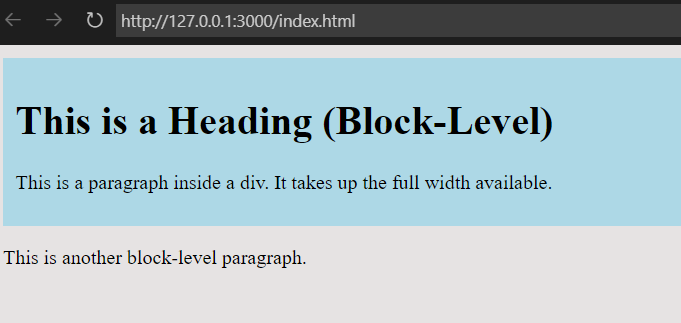Understanding the difference between HTML Block and Inline Elements is fundamental to creating well-structured and visually appealing web pages. Block-level elements are used for layout and structure, while inline elements are used for styling and smaller content pieces. By mastering these concepts and leveraging CSS, you can create flexible and responsive designs.
1. Block-Level Elements
Block-level elements are HTML elements that always start on a new line and take up the full width available (by default). They are used to structure the layout of a webpage and can contain other block-level or inline elements.
Key Characteristics of Block-Level Elements:
- Start on a new line.
- Take up the full width of their parent container.
- Can have width, height, margin, and padding set.
- Can contain other block-level or inline elements.
Common Block-Level Elements:
<div>: A generic container for flow content.<p>: Paragraph.<h1>to<h6>: Headings.<ul>,<ol>,<li>: Unordered lists, ordered lists, and list items.<header>,<footer>,<section>,<article>: Semantic HTML5 elements.<table>: Table.<form>: Form container.<hr>: Horizontal rule.<blockquote>: Block quotation.
Example of Block-Level Elements:
<!DOCTYPE html>
<html lang="en">
<head>
<meta charset="UTF-8">
<meta name="viewport" content="width=device-width, initial-scale=1.0">
<title>HTML Block</title>
</head>
<body>
<div style="background-color: lightblue; padding: 10px; margin: 10px 0;">
<h1>This is a Heading (Block-Level)</h1>
<p>This is a paragraph inside a div. It takes up the full width available.</p>
</div>
<p>This is another block-level paragraph.</p>
</body>
</html>Output:

2. Inline-Level Elements
Inline elements do not start on a new line and only take up as much width as necessary. They are typically used within block-level elements to style or structure smaller parts of content.
Key Characteristics of Inline Elements:
- Do not start on a new line.
- Take up only as much width as necessary.
- Cannot have width, height, or vertical margins set.
- Can only contain other inline elements or text.
Common Inline Elements:
<span>: A generic inline container.<a>: Anchor (hyperlink).<strong>: Bold text (semantic importance).<em>: Italicized text (emphasis).<img>: Image.<br>: Line break.<input>: Input field.<button>: Button.<label>: Label for form elements.<code>: Inline code snippet.
Example of Inline Elements:
<p>This is a paragraph with <span style="background-color: lightgreen; padding: 5px;">inline elements</span> like <strong>bold text</strong> and <a href="#">a link</a>.</p>Output:
This is a paragraph with inline elements like bold text and a link.
3. Key Differences Between Block and Inline Elements
| Feature | Block-Level Elements | Inline Elements |
|---|---|---|
| Default Display | Starts on a new line | Does not start on a new line |
| Width | Takes full available width | Takes only necessary width |
| Height/Margin | Can set height and margin | Cannot set height or margin |
| Nesting | Can contain block and inline | Can only contain inline |
4. Changing Display Behavior with CSS
You can change the default display behavior of an element using the CSS display property. This allows you to make block-level elements behave like inline elements and vice versa.
Common Display Values:
display: block;: Makes an element behave like a block-level element.display: inline;: Makes an element behave like an inline element.display: inline-block;: Makes an element behave like an inline element but allows setting width, height, and margins.
Example: Changing Display Behavior
<style>
.block-to-inline {
display: inline;
background-color: lightcoral;
padding: 5px;
margin: 5px;
}
.inline-to-block {
display: block;
background-color: lightyellow;
padding: 10px;
margin: 10px 0;
}
.inline-block-example {
display: inline-block;
width: 150px;
height: 50px;
background-color: lightblue;
padding: 10px;
margin: 10px;
}
</style>
<div class="block-to-inline">This is a block-level div turned into inline.</div>
<span class="inline-to-block">This is an inline span turned into block.</span>
<div class="inline-block-example">Inline-Block Example</div>
<div class="inline-block-example">Another Inline-Block</div>Output:
Conclusion
Understanding the difference between block-level and inline-level elements is fundamental to creating well-structured and visually appealing web pages. Block-level elements are used for layout and structure, while inline elements are used for styling and smaller content pieces. By mastering these concepts and leveraging CSS, you can create flexible and responsive designs.
